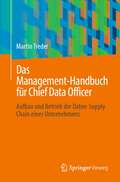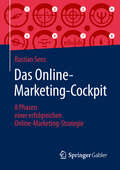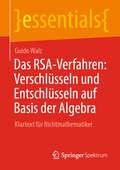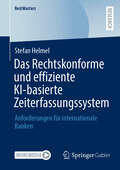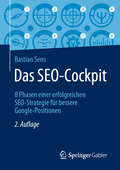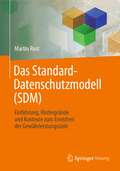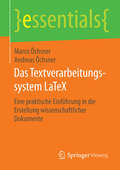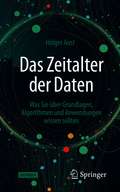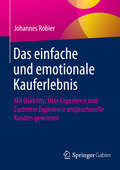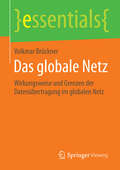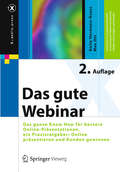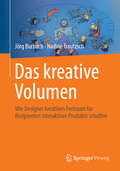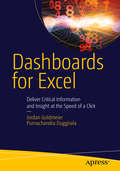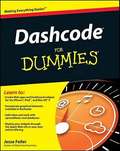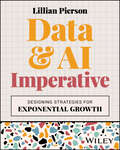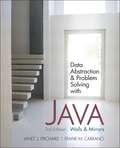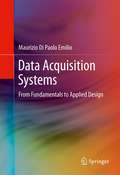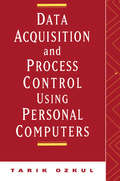- Table View
- List View
Das Management-Handbuch für Chief Data Officer: Aufbau und Betrieb der Daten-Supply Chain eines Unternehmens
by Martin TrederEs lässt sich nicht leugnen, dass das 21. Jahrhundert datengesteuert ist, wobei viele digitale Branchen auf die sorgfältige Erfassung und Analyse großer Mengen von Informationen angewiesen sind. Ein Chief Data Officer (CDO) in einem Unternehmen ist der Leiter dieses Prozesses, was diese Position oft zu einer Herausforderung macht. Das Chief Data Officer Management Handbook soll hier Abhilfe schaffen.In diesem Buch gibt der Autor Martin Treder Ratschläge, wie CDOs besser auf ihren Verantwortungsbereich vorbereitet werden können, wie sie einen nachhaltigeren Ansatz entwickeln und wie sie die typischen Fallstricke vermeiden können. Basierend auf den positiven und negativen Erfahrungen aktueller CDOs hilft das Chief Data Officer Management Handbook dabei, die ideale Struktur eines Datenbüros zu entwerfen, sie zu implementieren und die richtigen Leute an Bord zu holen.Wichtige Themen wie die Datenversorgungskette, die Datenstrategie und die Data Governance werden von Treder sorgfältig behandelt. Als CDO ist es wichtig, dass Sie Ihre Position mit Ihrem gesamten Team effektiv nutzen. Das Chief Data Officer Management Handbook ermöglicht es allen Mitarbeitern, die Verantwortung für die Zusammenarbeit im Bereich Daten zu übernehmen. Daten sind die Grundlage heutiger und zukünftiger technologischer Innovationen, und Sie könnten die Führungspersönlichkeit sein, die die nächste große Veränderung bewirkt.Was Sie lernen werden:Wichtige Elemente eines effektiven Datenmanagements anwendenSie erhalten einen umfassenden Überblick über alle Datenbereiche (die oft unabhängig voneinander verwaltet werden) Arbeiten Sie mit der Datenversorgungskette, von der Datenerfassung bis zur Datennutzung, einer Überprüfung aller relevanten Interessengruppen, der Datenstrategie und der DatenverwaltungFür wen ist dieses Buch gedacht?CDOs, Datenverantwortliche, Datenberater und alle Fachleute, die verstehen wollen, wie ein Datenbüro in einer Organisation funktioniert.
Das Online-Marketing-Cockpit: 8 Phasen Einer Erfolgreichen Online-marketing-strategie
by Bastian SensErstellen Sie mit diesem Buch Ihre eigene Online-Marketing-StrategieNutzen Sie dieses Buch über Online-Marketing, um Ihr eigenes Online-Marketing-Konzept zu erstellen und so alle für Sie relevanten Plattformen zu identifizieren und zu bedienen. Diese Fachlektüre erläutert Ihnen acht Phasen, in denen Sie Ihre eigene Online-Marketing-Strategie erstellen und diese in Ihrem Unternehmen umsetzen können. Dabei legt das Buch auch ein Augenmerk auf das immer wichtiger werdende Thema des Bewerbermarketings. Viele Unternehmen haben im Bereich Online-Marketing Nachholbedarf, weil sie nicht wissen, welche Plattformen für sie geeignet sind oder wie und welche Inhalte sie konzipieren können. In mehreren Schritten zeigt der Autor dem Leser den Weg zur eigenen Online-Marketing-Strategie. Er geht dabei wie folgt vor:In einer kurzen Einleitung erklärt Bastian Sens, weshalb Unternehmen ein Cockpit für das Online-Marketing benötigen.Eine Faktorenanalyse zeigt, was Unternehmen bei ihrer Strategie beachten sollten.Anschließend beschreibt das Online-Marketing-Buch acht Phasen, in denen eine eigene Online-Marketing-Strategie erstellt werden kann.Praktische Tipps helfen dabei, das erarbeitete Konzept umzusetzen. Acht Phasen zur Erstellung des Online-Marketing-KonzeptsMithilfe einer Schritt-für-Schritt-Anleitung kann der Leser seine persönliche Online-Marketing-Strategie erstellen. Dabei werden die folgenden Phasen durchlaufen:PositionierungZielgruppenbestimmungZielsetzungKanal- und Instrumentenauswahl, darunter SEO, Google Adwords und Social-Media-PortaleContenterstellungConversion-OptimierungControllingAutomatisierungMit seinen praktischen Tipps ist dieses Buch nicht nur hilfreich für Webagenturen, sondern Pflichtlektüre für alle Marketingleiter und Unternehmer, die ihren Betrieb in Sachen Online-Marketing voranbringen möchten.
Das RSA-Verfahren: Klartext für Nichtmathematiker (essentials)
by Guido WalzDieses kompakte essential vermittelt die mathematischen Grundlagen des RSA-Verfahrens. Es stellt dafür – bewusst beispielorientiert statt beweisvollständig – zunächst die algebraischen Grundlagen sowie den (erweiterten) euklidischen Algorithmus und schließlich natürlich das RSA-Verfahren selbst dar. Außerdem wird eine kurze Einordnung des Verfahrens in die Welt der Kryptographie gegeben und seine Risiken dargestellt.
Das Rechtskonforme und effiziente KI-basierte Zeiterfassungssystem: Anforderungen für internationale Banken (BestMasters)
by Stefan HelmelIn diesem Buch werden die Anforderungen an ein KI-gestütztes Zeitwirtschaftssystem am Beispiel einer internationalen Bank in Österreich untersucht. Die zentrale Herausforderung liegt darin, die Effizienzpotenziale durch Künstliche Intelligenz (KI) zu nutzen und gleichzeitig die strengen rechtlichen Rahmenbedingungen des Landes zu erfüllen. Die Relevanz des Themas ergibt sich aus der strategischen Bedeutung der Zeitwirtschaft, dem transformativen Potenzial von KI im Personalwesen und dem komplexen regulatorischen Umfeld in Österreich. Mithilfe eines qualitativen Forschungsansatzes und einer Single-Case-Study wurden semi-strukturierte Experteninterviews mit internen Stakeholdern aus den Bereichen HR, KI, Recht, Datenschutz und IT-Sicherheit geführt und durch eine Analyse interner Dokumente ergänzt.Die Ergebnisse zeigen, dass die strikte Einhaltung der rechtlichen Vorgaben – insbesondere des österreichischen Arbeitsrechts, der DSGVO-Grundsätze und der Mitbestimmungsrechte des Betriebsrats – eine unverhandelbare Grundlage darstellt. Ebenso entscheidend ist die proaktive Ausrichtung am EU AI Act für Hochrisiko-Systeme im HR-Bereich.
Das SEO-Cockpit: 8 Phasen einer erfolgreichen SEO-Strategie für bessere Google-Positionen
by Bastian SensIn diesem Buch werden die wesentlichen Erfolgsfaktoren der Suchmaschinenoptimierung erläutert und neben aktuellen Trends auch Handlungsanleitungen zur professionellen Einführung von SEO geliefert. Gespickt mit Beispielen aus der Agenturpraxis zeigt der Autor die acht essenziellen Phasen der Suchmaschinenoptimierung: Positionierung, Zielgruppenbestimmung, Zielsetzung, Kanalauswahl, Contenterstellung und EAT-Aufbau, Conversion- und Usability-Optimierung, technische Optimierung und Controlling. Falls Sie einen Website-Relaunch planen oder für Ihre bestehende Website in Google eine Top-Position erreichen möchten, ist dieses Buch die richtige Grundlage. Es richtet sich an Geschäftsführer von kleinen und mittelständischen Unternehmen sowie Start-ups und an Marketing-Manager sowie Marketingleiter.
Das Standard-Datenschutzmodell (SDM): Einführung in die Umsetzung der operativen Anforderungen der DSGVO
by Martin RostDas Standard-Datenschutzmodell (SDM) gilt spätestens seit 2020 deutschlandweit als etabliert, um normative Anforderungen der DSGVO in funktionale Anforderungen an die Praxis der Datenverarbeitungen zu transformieren. Wenn die Juristin zum Beispiel sagt: Diese Daten sind unverzüglich zu löschen! Dann ist aus juristischer Sicht alles Erforderliche gesagt. Für Praktiker*innen, die diese vermeintlich leichte Anforderung umzusetzen haben, können sich Unmengen an komplizierten Fragen stellen: Wie gesichert muss gelöscht werden? Kann man den installierten Löschprogrammen trauen? Wie muss das Löschen von Daten in welcher Auflösung dokumentiert und protokolliert werden? Wer ist eigentlich befugt, zu löschen, auch in den Backup-Dateien? Das SDM hilft, bei solchen Fragestellungen der Umsetzung zu begründeten Entscheidungen zu gelangen, um an ein vollständiges Set von aufeinander abgestimmten, wirksamen Schutzmaßnahmen zu gelangen. Dies ist von zentraler Bedeutung bei der Durchführung von Datenschutz-Prüfungen und -Beratungen, Datenschutz-Folgenabschätzungen und dem Betrieb eines Datenschutz-Managements. Die 2. Auflage wurde umfassend für das SDM in der Version 3.1 aktualisiert und erweitert. Neu hinzugekommen sind u.a. Kapitel über SDM-Tools und -Schulungen sowie über SDM-Konformität.
Das Standard-Datenschutzmodell (SDM): Einführung, Hintergründe und Kontexte zum Erreichen der Gewährleistungsziele
by Martin RostDas Standard-Datenschutzmodell (SDM) gilt spätestens seit 2020 deutschlandweit als etabliert, um normative Anforderungen der DSGVO in funktionale Anforderungen an die Praxis der Datenverarbeitungen zu transformieren.Wenn die Juristin zum Beispiel sagt: Diese Daten sind unverzüglich zu löschen! Dann ist aus juristischer Sicht alles Erforderliche gesagt. Für Praktiker*innen, die diese vermeintlich leichte Anforderung umzusetzen haben, können sich Unmengen an komplizierten Fragen stellen: Wie gesichert muss gelöscht werden? Kann man den installierten Löschprogrammen trauen? Wie muss das Löschen von Daten in welcher Auflösung dokumentiert und protokolliert werden? Wer ist eigentlich befugt, zu löschen, auch in den Backup-Dateien? Das SDM hilft, bei solchen Fragestellungen der Umsetzung zu begründeten Entscheidungen zu gelangen, um an ein vollständiges Set von aufeinander abgestimmten, wirksamen Schutzmaßnahmen zu gelangen. Dies ist von zentraler Bedeutung bei der Durchführung von Datenschutz-Prüfungen und -Beratungen, Datenschutz-Folgenabschätzungen und dem Betrieb eines Datenschutz-Managements.
Das Textverarbeitungssystem LaTeX: Eine praktische Einführung in die Erstellung wissenschaftlicher Dokumente (essentials)
by Andreas Öchsner Marco ÖchsnerMarco und Andreas Öchsner geben eine kompakte und beispielbasierende Einführung in die Erstellung professioneller Textdokumente mittels LaTeX. Sie führen die wichtigsten Elemente eines wissenschaftlichen Dokumentes in einfacher und verständlicher Weise ein und zeigen deren Umsetzung in der Makrosprache LaTeX. Ziel ist die Fokussierung auf die grundlegenden Befehle und deren Anwendung zur Gestaltung qualitativ hochwertiger Textlayouts. Hinweise zum Bezug und zur Installation von LaTeX vervollständigen die Zusammenstellung.
Das Virus im Netz medialer Diskurse: Zur Rolle der Medien in der Corona-Krise (ars digitalis)
by Peter Zimmermann Angela KrewaniDie Corona-Krise gewinnt durch die digital-mediale Verbreitung eine beunruhigende Präsenz, der sich niemand entziehen kann. Dabei handelt es sich nicht nur um die aktuelle journalistische Berichterstattung, sondern auch um das Netz der digitalen Kommunikationen, die das Virus in verschiedenen ästhetischen Formen repräsentieren und reflektieren. Eine wichtige Rolle spielen dabei die Visualisierungen der Pandemie vom allzeit präsenten Ikon des Virus bis zu den Datengrafiken der Durchseuchung. Mit diesen Mitteln entwickelt sich ein visuelles Regime, das wiederum in die mediale Berichterstattung und die Pandemie-Kommunikation zurückwirkt.Damit reagiert das Buch auf die aktuelle Pandemie und bietet eine breitgefächerte Aufarbeitung der unterschiedlichen medialen Repräsentationen des Virus.Das Buch vertritt einen dezidiert digital-medienwissenschaftlichen Ansatz, der die Medialität des Virus und der kontroversen Diskurse der Pandemie mit ihren komplexen und heterogenen Aspekten dokumentiert und analysiert. Damit unterscheidet es sich signifikant von stärker publizistischen oder soziologisch ausgerichteten Studien.
Das Zeitalter der Daten: Was Sie über Grundlagen, Algorithmen und Anwendungen wissen sollten
by Holger AustDaten werden überall gesammelt. Jeder Kauf, ob online oder offline, jede Autofahrt und jede Benutzung des Smartphones erzeugt Daten, die gespeichert werden. So entstehen Datenberge, die in atemberaubendem Tempo wachsen – für 2020 geht man von 40 Billionen Gigabytes aus. Aber was passiert dann mit diesen Daten? Wie werden sie ausgewertet? Und wer macht das? Holger Aust nimmt Sie mit auf einen unterhaltsamen Ausflug in die wunderbare Welt der Data Science. Sein Buch richtet sich an alle, die schon immer wissen wollten, wie Maschinen anhand von Daten lernen und ob sie dadurch (künstliche) Intelligenz erlangen. Sie erfahren natürlich auch, was neuronale Netze und Deep Learning eigentlich mit all dem zu tun haben. In leicht verständlichem Stil erhalten Sie außerdem Einblicke in die Funktionsweise der wichtigsten Algorithmen und lernen konkrete Beispiele, Herausforderungen und Risiken aus der Praxis kennen: Sie erfahren etwa, wie Mobilfunkanbieter ihre Kunden bei Laune halten, wie Erdbebenvorhersage funktioniert und warum auch Computer zum Schubladendenken neigen.
Das einfache und emotionale Kauferlebnis: Mit Usability, User Experience und Customer Experience anspruchsvolle Kunden gewinnen
by Johannes RobierBei der Entscheidung eines Kunden für den Kauf eines Produktes oder Dienstleistung sind viele Faktoren wichtig, die bewusst oder unbewusst wahrgenommen werden. Ausschlaggebend für Kaufentscheidung ist letztlich jedoch ein Gefühl des Vertrauens, das der Kunde entwickelt hat. Dieser "Reason to believe" ist der entscheidende Faktor, warum Produkte gekauft, weshalb Dienstleistungen in Anspruch genommen und wieso Kunden zu loyalen Stammkunden werden. Dieses Buch zeigt Ihnen von den psychologischen Grundlagen der Informationsvermittlung bis hin zu methodischen Anwendungen, wie Sie den ,,Reason to Believe" Ihrer Produkte und Dienstleitungen strukturiert erarbeiten, kommunizieren und in den Vordergrund stellen können.
Das globale Netz: Wirkungsweise und Grenzen der Datenübertragung im globalen Netz (essentials)
by Volkmar BrücknerVolkmar Brückner gibt einen Überblick über die Datenübertragung im Festnetz, durch Mobilfunk oder Satelliten sowie über globale mobile und optische Netze. Grenzen und Fehlerquellen für das Festnetz und die Übertragung bei der mobilen Kommunikation sowie Problemfelder in Technik und Ökologie werden angesprochen.
Das gute Webinar: Das ganze Know How für bessere Online-Präsentationen, ein Praxisratgeber: Online präsentieren und Kunden gewinnen (X.media.press)
by Anita Hermann-Ruess Max OttIn diesem Buch lernen Sie anschaulich und praxisnah, wie Sie ein gutes Webinar organisieren, produzieren und live durchführen.Sie erhalten Antworten auf die Fragen: Was sind Webinare überhaupt? Wie können Sie das Format „Webinar“ in Ihrem Unternehmen sinnvoll einsetzen? Welche Technik benötigen Sie für gute Webinare? Wie produzieren Sie Präsentationen onlinegerecht? Wie halten Sie ein Webinar überzeugend und fesselnd live? Wie nutzen andere Unternehmen und Organisationen dieses Format heute schon erfolgreich?Sechs Kapitel führen Sie in die Welt der Webinare ein mit vielen Materialien, Checklisten, Plänen und Inspirationshilfen. Auf einer extra Website zum Buch erhalten Sie die wichtigsten Vorlagen zum Herunterladen, ein Bonuskapitel zum Thema Onlinemarketing, Beispiel-Webinare zum Anschauen und viele weitere Informationen.
Das kreative Volumen: Wie Designer kreativen Freiraum für Rezipienten interaktiver Produkte schaffen
by Jörg Burbach Nadine TrautzschWie weit kann ein Spiel gehen, um uns in seine Welt eintauchen zu lassen? Das theoretische Modell des Kreativen Volumens betrachtet dazu alle narrativen und ludischen Elemente in ihrer Gesamtheit. Dieses Konzept lässt sich auf das Entwickeln und Erleben von Videospielen anwenden, indem es nicht nur Immersion und Einfühlung, sondern auch die subtile Kunst des Weglassens betont. Das Buch vereint disziplinübergreifende Ansätze, um kreative Prozesse sowohl auf Seiten der Entwickler:innen als auch der Spieler:innen zu fördern. Kern des Modells sind die drei Dimensionen: Kreatives Fundament (durch die Entwickler:innen gestaltete Elemente), Kreatives Potenzial (die schöpferische Interaktion der Spieler:innen) und Kreative Resonanz (Auswirkungen des Spiels über dessen Grenzen hinaus).Es bietet praxisorientierte Leitlinien, wie gestalterische Entscheidungen die emotionale, narrative und soziale Interaktion im Spiel formen können. Es zeigt auf, wie durch bewusste Gestaltung Freiräume für kreative Entfaltung geschaffen und reflektiert werden können und wir somit Spiele zu kulturellen Artefakten und Resonanzräumen entwickeln können. Mit Blick auf die zunehmende Komplexität interaktiver Produkte schafft das kreative Volumen ein Vokabular und einen Rahmen, um Spielentwicklung strategischer, wirkungsvoller und inspirierender zu gestalten. Die Zielgruppe umfasst Game Designer:innen, Entwickler:innen, Künstler:innen und Forscher:innen, die ihr Verständnis von kreativer Interaktivität vertiefen und die gestalterische Praxis auf ein neues Level heben möchten. Begleitmaterial unter https://www.kreatives-volumen.de
Das ultimative Buch über Point & Click-Adventures
by Joerg BurbachPoint & Click-Adventures sind mehr als nostalgisches Rätseln – sie sind interaktive Erzählkunst. Dieses Buch beleuchtet das Genre aus gestalterischer, narrativer und medienkultureller Perspektive. Es verbindet persönliche Anekdoten mit fundierter Analyse, deckt Designprinzipien, historische Entwicklungen und aktuelle Remakes ab. Es zeigt so, wie Adventures Lernprozesse, Kreativität und kollaboratives Denken fördern können. Ein Standardwerk für alle, die sich professionell und / oder leidenschaftlich mit Games im allgemeinen und Point & Click-Adventures im Besonderen beschäftigen – ob in Entwicklung, Forschung, Lehre oder einfach aus Liebe zum Genre.
Das verflixte Selbst: Menschliche Eigenwilligkeit und Künstliche Intelligenz
by Heiko ReischMenschen schreiben sich ein Selbst zu. Die Wissenschaften haben Mühe zu sagen, was das ist und wie es zustande kommt. Sie sind sich aber sicher, dass wir es haben und brauchen. Für Forscher ist es jedoch kaum greifbar und deshalb ein verflixtes Problem. Daran wird die Entwicklung einer starken KI scheitern, Menschen bleiben etwas anderes.
Das Öffentliche und das Private: Informationstechnologische Entwicklungen und deren Einfluss auf öffentliches und privates Leben (Die blaue Stunde der Informatik)
by Wolfgang OsterhageTechnologische Entwicklungen beeinflussen öffentliches Leben in Politik und Wirtschaft, aber auch unser eigenes, privates Dasein. Gewollt oder ungewollt kommen wir täglich – und sogar des Nachts, wenn wir schlafen – mit Technologien in Berührung, die wir selbst nur bedingt kontrollieren können oder wollen. Es gibt keine Lebenslage, in denen eine Berührung mit elektronischen Systemen nicht gegeben ist. Insofern hat die Menschheit ihre informatorische Unschuld für immer verloren, bis hin zum Missbrauch persönlichen Identitäten in sozialen Netzen, in denen ein Leben in Scheinidentitäten stattzufinden scheint. Information und Kommunikation sind Wirtschaftsfaktoren geworden, die am Ende des Industriezeitalters und am Beginn des Wissenszeitalters zu stehen scheinen. Das technisch Hergestellte wird dem Organischen immer ähnlicher. Natur und Maschinen verschmelzen und entziehen sich unserer Kontrolle. Man tut, was dem System nutzt. Das Leben wird zu einer Risiko- und Wahrscheinlichkeitsrechnung, und das Ich nur noch zu einem Interface.
Dashboard Design (River Publishers Series in Computing and Information Science and Technology)
by Michael Burch Marco SchmidInteractive visualization and visual analytics tools have been designed and developed in the past and will be developed in the future as well. In each application domain in which data is measured, generated, and recorded we see a potential candidate for an interactive visualization tool with the goal to find insights and knowledge in the data. This knowledge can be found either visually by humans’ interventions or algorithmically by the machine, in the best case by applying both concepts in combination as in visual analytics. One of the easiest ways to get an interactive visualization tool running is by means of dashboards, typically implemented as webpages that can run in a web browser and are accessible online, creating some kind of web-based solution. This book describes ways to design and implement dashboards based on the programming language Python, the graphics library Plotly, and Dash. The readers can use the provided dashboard codes as a starting point and extend the functionality and features on their desire. Technical topics discussed in the book include: Design in visualization Interaction principles in information visualization User interface design Linking Python, Dash, and Plotly Coding in Python Dashboard examples with Python code.
Dashboards for Excel
by Jordan Goldmeier Purnachandra DuggiralaThe book takes a hands-on approach to developing dashboards, from instructing users on advanced Excel techniques to addressing dashboard pitfalls common in the real world. Dashboards for Excel is your key to creating informative, actionable, and interactive dashboards and decision support systems. Throughout the book, the reader is challenged to think about Excel and data analytics differently--that is, to think outside the cell. This book shows you how to create dashboards in Excel quickly and effectively. In this book, you learn how to: Apply data visualization principles for more effective dashboards Employ dynamic charts and tables to create dashboards that are constantly up-to-date and providing fresh information Use understated yet powerful formulas for Excel development Apply advanced Excel techniques mixing formulas and Visual Basic for Applications (VBA) to create interactive dashboards Create dynamic systems for decision support in your organization Avoid common problems in Excel development and dashboard creation Get started with the Excel data model, PowerPivot, and Power Query What you'll learn Learn the visualization tools, charts, tables, and graphs important to management. Understand what management doesn't want to see in a report Turn around dashboards faster and cheaper than ever before Understand the key role dashboards play in an organization Analyze real-world dashboards to apply important features to your own organization Utilize understated, but powerful, Excel formulas and VBA code Avoid common pitfalls in Excel development and dashboard creation Get started with the Excel data model, PowerPivot, and Power Query Who this book is for This book is for many people. It's for the developer who isn't satisfied by accepting Excel's so-called limitations, who feels that with some creativity, spreadsheets can become a powerful and informative decision engine. It's for the Excel user who has spent hours--even outside of work--experimenting with Excel formulas and macros in an attempt to find a better, more efficient way to complete a task. It's for the user who believes in the power of the spreadsheet. Table of Contents Part I. Dashboards and Data Visualization 1. Introduction to Dashboard and Decision Support Development 2. A Critical View of Information Visualization 3. The Principles of Data Visualization in Microsoft Excel 4. The Excel Data Presentation Library Part II. Excel Dashboard Design Tools and Concepts 5. Getting Started: Thinking Outside the Cell 6. Visual Basic for Applications for Excel, a Refresher 7. Avoiding Common Pitfalls in Development and Design 8. The Elements of Good Excel Dashboards and Decision Support Systems Part III. Formulas, Controls, and Charts 9. Introducing Formula Concepts 10. Advanced Formula Concepts 11. Metrics: Performance and Context 12. Charts with Heart (or, How to Avoid a Chart Attack) 13. Creating an Interactive Gantt Chart Dashboard 14. An Interactive Gantt Chart Dashboard, Data Visualization 15. An Interactive Gantt Chart Dashboard, Data Details on Demand Part IV. From User Interface to Presentation 16. Working with Form Controls 17. Getting Input from Users 18. Storage Patterns for User Input 19. Building for Sensitivity Analysis 20. Perfecting the Presentation Part V. Data Models, PowerPivot, and Power Query 21. Data Model Capabilities of Excel 2013 22. Advanced Modeling with Slicers, Filters, and Pivot Tables 23. Introduction to Power Query 24. Introduction to PowerPivot
Dashcode For Dummies
by Jesse FeilerCreate widgets and Web apps for the iPhone, iPad, and Mac OS X with DashcodeDashcode is a software application that makes it quick and easy to create dashboard widgets and Web apps for Mac computers, iPhone, and iPad. Widgets and Web apps connect users with content from the Web such as Twitter feeds, movie showtimes, news updates, and more. Dashcode provides a library of graphic elements and standard code that you just drag-and-drop into your app, and this guide shows you how to use it to bring your idea to life. Learn to create, customize, and distribute your apps, even if you're a programming novice.Dashcode provides a quick and easy way to create dashboard and Web widgets for Apple devicesThis guide shows you how to use the built-in Dashcode tools, including graphical elements and functional code, to create Web apps using your dataLearn to customize your app, add media, retrieve data from Web services for your app, and deploy your widgetsEven if you're new to programming, you can learn to create and distribute widgets with DashcodeDashcode For Dummies gets you up and running with this cool tool for creating unique Web apps and dashboard widgets.
Data & AI Imperative: Designing Strategies for Exponential Growth
by Lillian PiersonUnlock predictable bottom line growth through tailored data and AI strategies. In The Data & AI Imperative: Designing Strategies for Exponential Growth, celebrated data-driven growth leader, Lillian Pierson, delivers a masterclass in developing custom strategies to harness the full potential of data and AI within your organization. This book offers a clear, actionable roadmap for leveraging your company's data and technology assets to drive significant, reliable growth. With over two decades of experience, Pierson unveils her proprietary STAR framework through which you'll learn to survey, take stock of, and assess your company's current state. Finally, you'll be guided on how to recommend strategies that drive growth via the execution of optimally positioned data- and AI- intensive projects or products that directly improve your business bottom line. From conception to execution, learn to: Identify high-impact opportunities for data or AI interventions within your business. Assess your organization's readiness and data literacy to ensure successful outcomes. Implement practical, effective tactics for overseeing your data-intensive projects, from strategic plans to profitable realities. Develop and deploy AI and data strategies that exceed your business goals. While ideal for executives, managers, and other leaders of data- or AI-intensive companies, The Data & AI Imperative is also invaluable to data and technical professionals who aspire to elevate their impact by turning technical expertise into strategic leadership success.
Data Abstraction and Problem Solving with Java: Walls & Mirrors (3rd Edition)
by Janet J. Prichard Frank CarranoThe book aims to give students a superior foundation in data abstraction, object-oriented programming, and other modern problem-solving techniques.
Data Acquisition Systems: From Fundamentals to Applied Design
by Maurizio Di Paolo EmilioThis book describes the fundamentals of data acquisition systems, how they enable users to sample signals that measure real physical conditions and convert the resulting samples into digital, numeric values that can be analyzed by a computer. The author takes a problem-solving approach to data acquisition, providing the tools engineers need to use the concepts introduced. Coverage includes sensors that convert physical parameters to electrical signals, signal conditioning circuitry to convert sensor signals into a form that can be converted to digital values and analog-to-digital converters, which convert conditioned sensor signals to digital values. Readers will benefit from the hands-on approach, culminating with data acquisition projects, including hardware and software needed to build data acquisition systems.
Data Acquisition Using LabVIEW
by Behzad EhsaniTransform physical phenomena into computer-acceptable data using a truly object-oriented language About This Book • Create your own data acquisition system independently using LabVIEW and build interactive dashboards • Collect data using National Instrument's and third-party, open source, affordable hardware • Step-by-step real-world examples using various tools that illustrate the fundamentals of data acquisition Who This Book Is For If you are an engineer, scientist, experienced hobbyist, or student, you will highly benefit from the content and examples illustrated in this book. A working knowledge of precision testing, measurement instruments, and electronics, as well as a background in computer fundamentals and programming is expected. What You Will Learn • Create a virtual instrument which highlights common functionality of LabVIEW • Get familiarized with common buses such as Serial, GPIB, and SCPI commands • Staircase signal acquisition using NI-DAQmx • Discover how to measure light intensity and distance • Master LabVIEW debugging techniques • Build a data acquisition application complete with an installer and required drivers • Utilize open source microcontroller Arduino and a 32-bit Arduino compatible Uno32 using LabVIEW programming environment In Detail NI LabVIEW's intuitive graphical interface eliminates the steep learning curve associated with text-based languages such as C or C++. LabVIEW is a proven and powerful integrated development environment to interact with measurement and control hardware, analyze data, publish results, and distribute systems. This hands-on tutorial guide helps you harness the power of LabVIEW for data acquisition. This book begins with a quick introduction to LabVIEW, running through the fundamentals of communication and data collection. Then get to grips with the auto-code generation feature of LabVIEW using its GUI interface. You will learn how to use NI-DAQmax Data acquisition VIs, showing how LabVIEW can be used to appropriate a true physical phenomenon (such as temperature, light, and so on) and convert it to an appropriate data type that can be manipulated and analyzed with a computer. You will also learn how to create Distribution Kit for LabVIEW, acquainting yourself with various debugging techniques offered by LabVIEW to help you in situations where bugs are not letting you run your programs as intended. By the end of the book, you will have a clear idea how to build your own data acquisition system independently and much more. Style and approach A hands-on practical guide that starts by laying down the software and hardware foundations necessary for subsequent data acquisition-intensive chapters. The book is packed full of specific examples with software screenshots and schematic diagrams to guide you through the creation of each virtual instrument.
Data Acquisition and Process Control Using Personal Computers
by Ozkul""Covers all areas of computer-based data acquisition--from basic concepts to the most recent technical developments--without the burden of long theoretical derivations and proofs. Offers practical, solution-oriented design examples and real-life case studies in each chapter and furnishes valuable selection guides for specific types of hardware.
